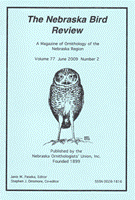Nebraska Ornithologists' Union

Nebraska Bird Review
Date of this Version
3-1997
Document Type
Article
Citation
"Notes on Bird Sightings in Nebraska March 1997," from Nebraska Bird Review (March 1997) 65(1).
Abstract
Albino Eastern Bluebirds. On 24 July 1996, I banded two totally white Eastern Bluebirds in Sarpy County, Nebraska. These two birds were in a nest with two other normally plumaged siblings. They were not only white-plumaged, their feet and bills were white and the eyes were a pinkish-red. They were just as well developed as the two normal birds and were ready to fledge, which they did the following day.
I believe these birds fit the description of total albinism as defined by John K. Terres in The Audubon Encyclopedia of North American Birds. He defines total albinism as the rarest form, in which the bird has a complete absence of melanin from the eyes, skin, and feathers.
-Ruth C. Green
American Goldfinch. Bird banding tells us many things about various species - where they migrate, distribution, age, and much more. I had an experience with a female American Goldfinch recently that I never dreamed would happen. I banded this bird 21 March 1996 in my Bellevue yard. On 12 March 1997, while banding at Ft. Kearny near Minden, NE, I renetted the same bird - a year later and 185 miles west of Bellevue. The chances of this happening are so remote that I can't imagine what the odds would be. What was surprising was not the distance the bird had moved, but that the same bander encountered it at such widely separated places.
-Ruth C. Green


Comments
Copyright 1997, Nebraska Ornithologists' Union. Used by permission.